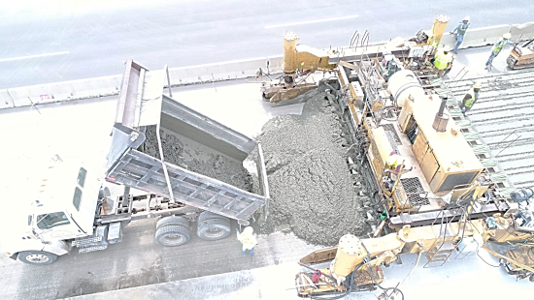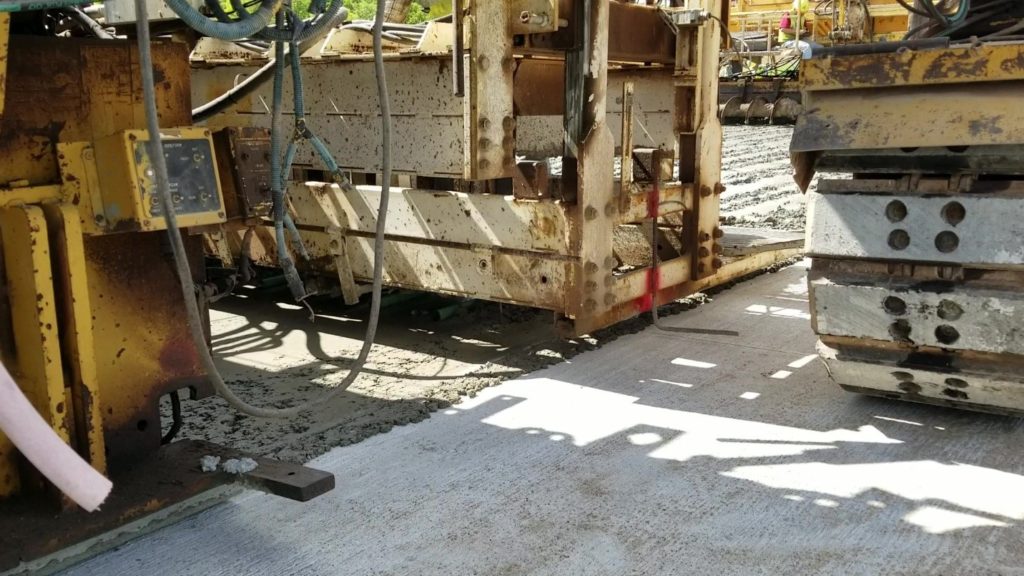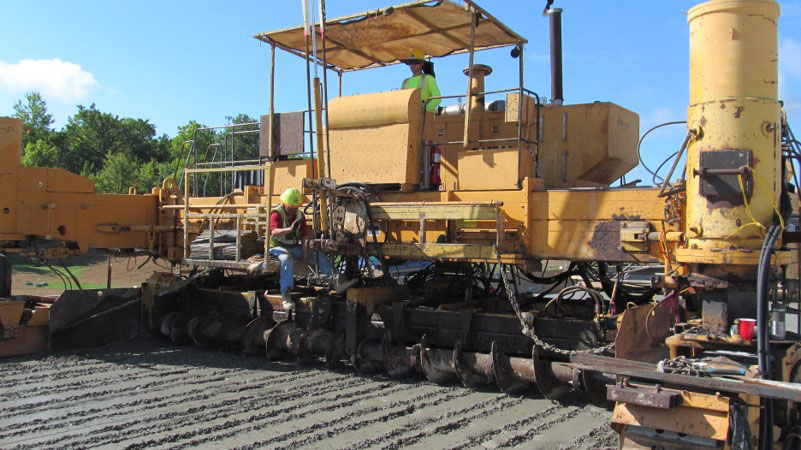Heavy Equipment Manufacturing Manual Dowel Bar Insertion Alternative
Dowel bar insertion or “DBI” is the process for
mechanically inserting reinforcing dowel bars into concrete during the paving
process. It is intended to eliminate
tied rebar cages or mats placed in front of the paver. The traditional method of dowel bar insertion
is the automatic dowel bar inserter which is a highly automated and dedicated
machine.

The dowel bar inserter offers contractors advantages of
convenience, flexibility and labor cost savings. With no tied cages or baskets in front of the
paver, it allows the concrete to be delivered and placed directly in front of
the paver rather that requiring a placer, pump or conveyor to deliver concrete
from the side. A dowel bar inserter also
eliminates the need to purchase the pre-tied rebar cages or baskets and the
labor required to place them.
There are several challenges with the traditional
automatic dowel bar inserter system.
- There is inconsistency of bar placement. Bars are often missing and misplaced. Because of the automated nature of the
process, there is no way to verify the correct placement until the testing
equipment (sonar, etc.) test the placement and then it is too late as tear out
is then required. Because of this, some
states in the USA have banned automatic DBI systems.

- Current Automatic DBI systems are extremely
complicated. There are many moving parts
that require extreme precision. This
creates constant mechanical issues. - Unwieldy size of the equipment requires
disassembly/reassembly for movement to and from the job site. A crane is required and the machine is down
for days. - An automatic DBI system is overwhelmingly
expensive, costing upwards of $2 million USD. - The machine has limited use, it is restricted to
DBI projects without significant modification.
The HEM Manual Dowel Bar Inserter (MDBI) Alternative
HEM has developed as alternative to the automatic DBI
system which achieves the advantages discussed above and addresses the
challenges. The Manual Dowel Bar Inserter (MDBI) system utilizes standard
paving equipment with an attachment which allows for controlled dowel bar
insertion.
The MDBI attachment connects to the rear of a standard slip form paver and uses the existing hydraulics. The dowel bars are placed into the delivery chutes by operators on the work platform and pressed into the concrete by a series of hydraulically driven rams.

The Six Step HEM MDBI Process
FIRST. The concrete is delivered via dump truck or transit mixer. The concrete can be placed directly in front of the first paver as no dowel bar cages or baskets are obstructing. No additional placing equipment is needed.

SECOND. The first slip form paver paves as normal. Vibrators, tamper bars and pans consolidate as a normal or non-DBI project.
THIRD. As the first machine approached the designated dowel bar insertion point, the operator stops the machine momentarily. Insertion points are visually marked on the ground or overlapping pour with a stake or paint. The MDBI operator station has a switch which allows the machine travel to be paused (the vibrators, augers, tampers, etc., continue to run). This pause allows for correct placement of the bars without dragging the bars through the newly poured concrete.

FOURTH. Once the machine is stopped, the operator cycles the MDBI to insert the dowel bars into the concrete. The operator opens the gates on the chutes to release the dowel bars onto the top of the newly consolidated concrete. Then he and workers inspect the drop to ensure that all the dowel bars are in the correct position and orientation.
The operator now lowers the carriage of the MDBI, which
starts the vibrators and lowering rams to drive the dowel bars into the
concrete to the appropriate depth. The
operator then raises the carriage of the MDBI, pulling the rams from the
concrete and shutting off the vibration.
While the carriage is cycling, the workers are reloading the chutes with
the dowel bars for the next cycle. The
operator now releases the paver and it continues paving forward until the next
dowel bar insertion point.
NOTE: This entire cycle takes approximately 40-45 seconds,
so the paver is stopped for less than
a minute typically.
FIFTH: As the first paver moves forward workers inspect the freshly inserted dowel bars for proper placement and orientation. Any adjustments can be made at this time.

SIXTH. A second paver closely follows behind the first paver to reconsolidate the concrete and provides the smooth finished surface. If a transverse center dowel bar is required, it is inserted with this machine. The auger is NOT run on the second machine so as not to disturb the consolidation.
-

Second Machine Following the First -

Center Dowel Bar Insertion
The tamper bar and vibrators run on the grade level to
liquify just the concrete surface for the pans to provide the final
consolidation and finish. Burlap is drug
behind the second machine or on a trailing texture cure machine if required.

Advantages of the HEM MDBI System
With the HEM MDBI system you receive all the advantages
of a DBI system (no dowel bar cages, labor and equipment saving) PLUS:
- Cost. Two
machines with the HEM MDBI attachment cost less that a traditional Automatic
DBI. - Dual Purposed.
When the MDBI is not needed, the two pavers can be easily converted to
traditional slipform paving. - Ease of Maintenance. Significantly fewer moving parts.
- Reliable.
Visually verified
placement of dowel bars. - Transportable.
Each machine can be self-loaded onto a trailer for movement to/from work
site. - Resale Value.
As standard slip form pavers, each machine can be resold for everyday
use.
Click on video to watch the HEM MDBI system in operation.
Contact HEM
Your contacts at HEM are:
- Darren Huinker for USA domestic at
+1.319.240.9068 or Darren@hempaving.com.
- For international contacts, Rick Eisiminger at
+1.540.729.0619 or rick@hempaving.com.
The HEM website is www.hempaving.com.

